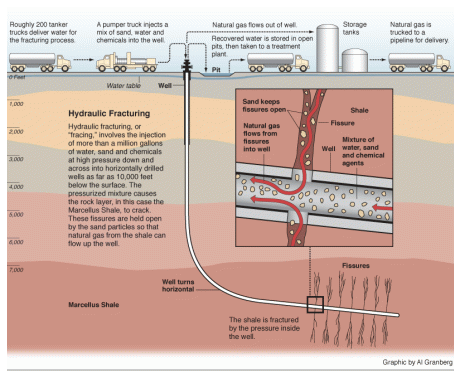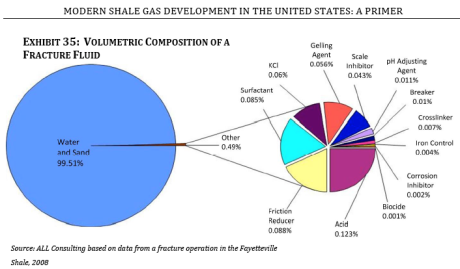Hydraulic fracturing, or "fracking," is a drilling technique that has earned a lot of media coverage lately – especially in regard to natural gas. In the last couple of years, it has been credited with dramatically increasing U.S. and world natural gas reserves enough to potentially transform global energy markets previously dominated by coal.
However, there are warranted concerns about polluted groundwater near fracking sites most vividly demonstrated by videos of flammable drinking water arriving through kitchen faucets as shown in last year's investigative documentary film "Gasland." Yet the most recent fracking headlines came late last week when the Environmental Protection Agency instructed nine major companies to disclose what chemicals they use in the process.
Like many other energy and environmental issues, fracking is not a topic that lends itself to intelligible sound bites – background information is necessary to grasp and engage in the debate. Below, I have posted a number of questions and answers about fracking. If anyone has additional questions unanswered here, please feel free to post them and I will do my best to track down an authoritative answer. So, we begin with the basics:
What is fracking?
Let's hear it from the horse's mouth – in this case, Energy In Depth, an industry front group:
"Some oil and natural gas wells flow more easily than others. In many cases—up to 90 percent, in fact—it is necessary to stimulate well sites to allow the energy contained thousands of feet below ground to rise to the surface for collection. …By creating or even restoring fractures, the surface area of a formation exposed to the borehole increases and the fracture provides a conductive path that connects the reservoir to the well. These new paths increase the rate that fluids can be produced from the reservoir formations, in some cases by many hundreds of percent."
Natural gas is the cleanest burning fossil fuel. Although it is not truly "clean" in terms of either traditional or greenhouse gas emissions, it is preferable to coal for electricity generation and, in compressed form, can be used instead of gasoline. Many people view natural gas as a short- to medium-term transition fuel on the way to a clean energy economy. That would require extensive natural gas resources, and hydraulic fracturing does provide access to vast additional reservoirs here at home.
Hydraulic fracturing can enhance recovery from traditional wells, but its primary benefit is enabling production of "unconventional" natural gas resources (described below). According to the Department of Energy, unconventional American natural gas resources have increased nearly 65% in the last decade – mostly as a result of technological advances (to fracking methods, although the concept has been around for 60 years) rather than discovery of new reservoirs. Already, unconventional sources account for 46% of current US natural gas production.
Why do we use fracking?
Like oil, natural gas forms deep underground. Its low density causes it to slowly rise through the earth from the depth at which it formed toward the surface. In some places, those hydrocarbons reach the surface in natural seeps like the La Brea Tar Pits in Los Angeles. More often, however, the rising gas (and oil) become stuck beneath impermeable geological formations known as "traps." Beneath these traps, gas and oil accumulate in high concentrations, or "reservoirs."
In the graphic above, the gray "seal" is an impermeable rock layer. At the left side, it has formed a bend (which in three dimensions would be roughly dome-shaped) that has trapped upwardly migrating natural gas. This is what is known as a "conventional" natural gas reservoir. To obtain that gas, you simply drill a borehole straight down into the reservoir and pump it out. The source rock beneath the trap is porous (like limestone) and small channels between pores enable gas to flow through the rock. Visualize the drilling apparatus as a straw sucking out liquid; more liquid from deeper in the reservoir gets pulled in as the pumping continues.
The darker gray band in the graphic contains a shale formation rich in natural gas. Shale gas is an "unconventional natural gas" resource. It is defined by its low permeability, and gas cannot flow easily through it. A vertical borehole would not access a significant quantity of hydrocarbons because the gas is separated into isolated pockets within the rock. This is a bit more abstract, but now visualize trying to use a straw to extract juice from a grapefruit. You can access the pockets you pierce with the straw, but sucking will not help empty any pockets you have not directly punctured.
Of course, shale is not a grapefruit. It is a sedimentary rock, so it has many horizontal layers deposited over time. When stressed, the rocks tend to fracture vertically, opening up pore space between many different pockets. Drillers can access economical quantities of gas by drilling horizontally through a shale play and using hydraulic fracturing to open up those vertical fractures.
How does fracking work?
As in the graphic below, to economically extract natural gas from a shale formation, a borehole is drilled down several thousand feet to the desired depth. Oftentimes the well then turns horizontal, drilling a long distance laterally within the shale play. Then the well is cased like a normal well: steel pipes are inserted and then surrounded by cement. After that, a "perforating gun" is lowered into the well at depth. It contains explosives designed to blow through the steel and cement in certain locations at production depth that will enable hydrocarbons to flow into the pipes. Once the perforating gun is fired, then the fracking can begin.
A combination of water and other chemicals, many of them toxic, are pumped into the well at very high pressures – enough to break the rock. This "fracking fluid" is designed to cause more fractures in the rock and expand them to reach more pockets of oil and gas within the shale formation. Sand or other similar particles are used as a "proppant" to keep the fractures open so that gas and oil can flow through (the high natural pressure at these depths would otherwise close the fracture channels once the fluid was drained). Then production can begin/continue.

This video, also from Energy in Depth, explains the process:
How is fracking dangerous/why do people oppose it?
Fracking requires massive quantities of water. According to the Department of Energy, hydraulic fracturing in a single well generally uses 2-4 million gallons of water. Although clean water is cheap and plentiful in America today, freshwater is not an unlimited resource. Scaling up fracking would consume billions of gallons of water. Even without using billions of gallons of clean water to get natural gas, 1/3 of all counties in the US are projected to face water shortages by midcentury and more than 400 of those counties face extremely high risk of water shortages.
But the more serious immediate concern is the "fracking fluid." Along with water, companies that employ fracking inject toxic chemicals into the ground. What chemicals? We're not entirely sure. Fracking fluid is largely unregulated, so they could be nearly anything. We know a few, and there are other reports of chemicals that pose both immediate and chronic health risks. But drilling companies have long objected to disclosing the toxic chemicals they inject into our groundwater, comparing asking for a specific list to asking Coke to give up their secret formula. Except when Coke spills, it doesn't kill 17 cows or poison fish. We don't know exactly what these chemicals are, but we know what they do.

The industry assures us that their fracking fluid is safe. But surely some of these chemicals, perhaps the "biocide," for example, are dangerous if they migrate into our groundwater as they have done before.
Industry groups like to downplay safety risks by mentioning that more than 99% of the fluid used in fracking is just water. But remember, a single well can use 2-4 million gallons of water, so that still means 20,000-40,000 gallons of toxic chemicals. And whatever those chemicals are, we know they leak into the groundwater from which we drink, they have proven lethal to animals, and they have already proven to have significant health impacts for people as well – even just from showering in contaminated water.
Until we know what's being put into our water, it is fully reasonable that communities near fracking sites are resisting the practice. Earthworks has a good list of fracking myths and facts that help detail the concerns.
Where is fracking being used?
There are sizable shale formations around the country from which natural gas could be extracted with hydraulic fracking (see map below). One of the most promising is the Marcellus Shale formation centered over Pennsylvania and New York. The most vocal opposition is currently in New York, where this week, concerned citizens will have the chance to halt fracking until they are told exactly what chemicals the drilling companies want them to drink.

Shale basins around the country contain recoverable natural gas reserves. Fracking is becoming an industry standard, so federal regulations – or lack thereof – have a significant impact from sea to shining sea.
Is fracking regulated?
Yes and no. Technically, a number of federal laws regulate fracking. The Clean Water Act regulates the surface discharge of wastewater and storm water runoff. The Clean Air Act limits airborne emissions from engines as well as drilling and processing equipment. Additionally, the National Environmental Policy Act requires companies to analyze the potential environmental impacts of exploration and production.
There is a notable exception from this list: the Safe Drinking Water Act (SDWA). What about the toxins injected underground? The SDWA rightly regulates toxic chemicals injected into our drinking water. Unfortunately, as Earthworks explains, fracking fluid is specifically exempted from this regulation by the "Halliburton Loophole" in the 2005 Energy Act:
"Despite the widespread use of the practice, and the risks hydraulic fracturing poses to human health and safe drinking water supplies, the U.S. Environmental Protection Agency ("EPA") does not regulate the injection of fracturing fluids under the Safe Drinking Water Act. The oil and gas industry is the only industry in America that is allowed by EPA to inject known hazardous materials — unchecked — directly into or adjacent to underground drinking water supplies.
This exemption from the SDWA colloquially bears Halliburton's name because it is widely perceived to have come about as a result of the efforts of Vice President Dick Cheney's Energy Task Force. Before taking office, Cheney was CEO of Halliburton — which patented hydraulic fracturing in the 1940s, and remains one of the three largest manufacturers of fracturing fluids. Halliburton staff were actively involved in review of the 2004 EPA report on hydraulic fracturing." -Earthworks
Halliburton (and the Bush administration) justified this exemption by advancing the claim that all fracking fluids are extracted from the well and thus do not enter the groundwater. They have argued in court that these chemicals are both safe and not left underground anyways. That is not true. The toxicity of fracking fluid components is discussed and linked above, but a recent investigation also revealed that up to 85% of fracking fluid is indeed left underground where it can and has seeped into drinking water supplies.
Fracking currently enjoys an additional exemption from reporting fracking fluid chemicals under the 1986 Emergency Planning and Community Right-to-Know Act. Fortunately, the EPA is now reviewing the safety of this practice.
Fracking and natural gas may well have an important role to play in our energy future, but from fracking pollution to the recent oil spills (plural) and the California gas line explosion, it is clear this industry is in need of modern regulations.





No comments:
Post a Comment